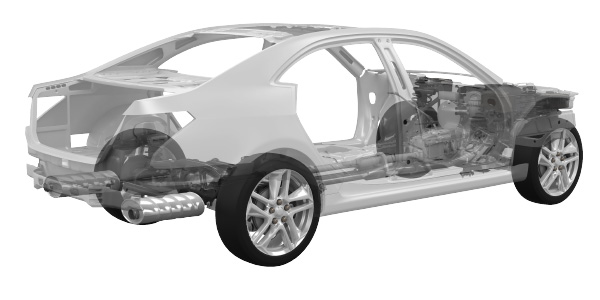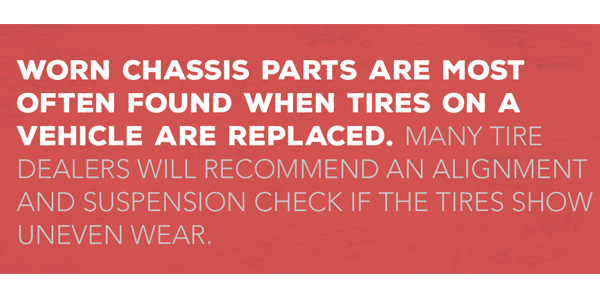
Worn chassis parts such as tie rod ends, ball joints, idler arms and control arm bushings can cause a lot of problems such as rapid or uneven tire wear, suspension noise and poor handling. They also can be potentially dangerous if a failure causes part of the suspension to collapse and a loss of steering control. Because of this, chassis parts need to be inspected regularly by a skilled professional, and replaced if wear exceeds specifications, or a component is damaged or dangerously corroded.
But how often are chassis parts actually inspected? Not very often, in most cases. Unless a motorist brings their vehicle into a repair facility because of a suspension noise, steering or tire-wear problem, chances are the chassis never will be inspected unless it also is receiving a brake job or other chassis-related repairs or is getting a new set of tires or an alignment. The rest of the time, the chassis is out of sight and out of mind for most motorists.
At the very least, the tires, shocks, struts, springs, ball joints, tie rods ends and control arms should be visually inspected at every oil change for any obvious signs of wear or trouble.
There have been numerous auto manufacturer recalls for corroded control arms in recent years, but who checks control arms for severe rust? In some cases, badly corroded control arms have failed, causing the suspension to collapse and the vehicle to lose control – and in some cases with fatal results.
Worn chassis parts often can’t be seen because the wear is internal. The outside of a tie rod end or ball joint may look like new, but inside it may have too much slop. As a rule, tie rod ends should have no visible play when the steering is turned back and forth. Ball joints are harder to measure because a load-bearing joint usually has to be unloaded by raising the suspension before play can be accurately measured. And some people (including some so-called “professional installers”) still don’t know how to accurately measure play in a ball joint. The maximum acceptable play in a ball joint can vary quite a bit depending on the design of the joint, its location in the suspension, the application and how hard to lean on a pry bar when checking play. Play should be measured with a dial indicator – unless a joint is totally shot and is on the verge of pulling apart.

Most of the time, worn chassis parts are found when tires on a vehicle are replaced. Many tire dealers will recommend an alignment and suspension check if the tires show uneven wear. Worn tie rod ends allow the front tires to “toe-out” and scrub as they roll, producing accelerated wear on the inner shoulders of both front tires. A bad ball joint may allow a change in camber that causes a tire to lean inward. This will produce shoulder wear on the inside shoulder, but only on one side (the bad side). A bad control arm bushing can do the same thing.
If a customer needs a replacement tie rod end, ball joint, control arm bushing, control arm or unitized control arm assembly (that includes the ball joint), be aware that tie rod ends on the right and left sides of a vehicle often differ. Upper and lower ball joints on short-long arm (SLA) suspensions also differ. Some right and left control arms also can differ in length or design, so make sure your customer gets the correct parts.
Although it isn’t always necessary, it’s often a good idea to replace the tie rod ends, ball joints, control arms or control arm bushings on both sides of a vehicle when a part of either side has failed. This is especially true on older high-mileage vehicles. Tie rod ends and ball joints on the right passenger side tend to wear somewhat faster than those on the left side because right-hand turns generally are sharper, thus more joint rotation and wear.
Chances are the tie rods, ball joints or control arm bushings on both sides of an older high-mileage vehicle likely need to be replaced, even if only one has obviously failed.







